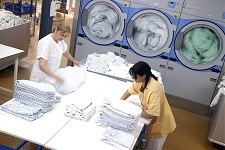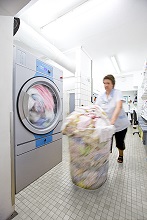 INWOOD, N.Y.—Your laundry staff is a busy bunch. Sorting loads, transferring them from washer to dryer and finally, finishing, folding and getting them shelved. Still, most days they find time to unknowingly dump a bucket of money in the trash.
INWOOD, N.Y.—Your laundry staff is a busy bunch. Sorting loads, transferring them from washer to dryer and finally, finishing, folding and getting them shelved. Still, most days they find time to unknowingly dump a bucket of money in the trash.
True, the bucket reference may be a bit dramatic, but chances are there is an activity going on in your laundry that is costing the operation money—human error.
Managers employ a variety of tactics to help prevent human error. They focus on bringing in quality employees and spend ample time training them. But short of constant supervision, which, let’s face it, isn’t realistic, human error plagues laundries in any industry.
Even the advent of programmable washer controls in the 1970s and similar technology for dryers in the 1990s didn’t do away with the problem. Refinements to the controls in recent years may have helped. Still, despite the programming breakthroughs, most equipment is not able to trump or correct an operator’s poor choice. Or can it?
Under-loading—the Laundry Killer
What does a full load look like before the washer door is closed? It’s a simple question, but chances are your staff members probably have different answers. Welcome to the world of under-loading. Laundry managers are well aware that under-loading of washers is about as common as a rewash load. In fact, in a recent survey of laundry professionals, most estimated that 70 percent of all washloads are under-loaded.
Remember that bucket of money being tossed in the trash? Here it comes. The simple human error of under-loading wastes water, utilities (energy to heat the water) and laundry chemicals.
Consider how many washes your facility processes daily and what the true costs of this simple human error could be.
Employee training is the obvious first line in protecting against under-loading, though, as discussed, it’s not a foolproof answer. There is, however, technology today that totally overcomes the problem.
Washers now on the market weigh the load before water is added to the cylinder. If the weight comes in under capacity, the washer automatically will adjust the water level to match the size of the load. In addition, it will make the same adjustment on each fill in the cycle. With most wash cycles utilizing five fills, the savings are significant. You could consistently save up to 30 percent or more water on every less than full load—that is a tremendous amount of savings over the year.
Because only adjusting water levels could hamper wash quality by not sufficiently diluting laundry chemicals, the technology goes a step further. The washer control alerts the chemical dispensing system of the under-load condition and it then automatically adjusts dosing to match the reduced water fills.
Dry, Dry, & Dry Again
 Human error and its resulting costs to the operation aren’t only confined to the wash side. Over-drying loads is just as frequent of an occurrence and just as costly. In the old days of dial controls, the condition was pretty visible when staff cranked a timer as far to the right as it would go. That way they were assured the load would be dry.
Human error and its resulting costs to the operation aren’t only confined to the wash side. Over-drying loads is just as frequent of an occurrence and just as costly. In the old days of dial controls, the condition was pretty visible when staff cranked a timer as far to the right as it would go. That way they were assured the load would be dry.
Employees aren’t totally to blame. We’re expecting them to know that cotton-poly sheets dry faster than 100-percent cotton pieces and that towels take longer than sheets. With so much to consider, staff will play to the lowest common denominator and crank that figurative dial to the right, hitting cycle repeat for each load that comes after. In their eyes, the process works—all loads always come out dry. Management sees it differently as over-drying wastes utilities and time. It’s also a fact that over-drying degrades linens, causing them to wear out faster.
Laundry professionals surveyed believe over-drying occurs 60 percent of the time and for an average of six minutes. Managers with two, three, four or more dryers can multiply these findings to see the full impact on their specific laundry.
Ending the Over-dry Cycle
This is where modern technology can correct the human error action. Though operators may decide to blast heat at a load and over-dry it, sensors designed into some units overrule the decision and automatically stop the dryer once a specific moisture level has been attained.
Programming behind the process is as simple as sensors measuring the temperature of exhaust air. As the hot air r¬¬educes moisture in the load, it leaves the cylinder cooler. But as the load’s moisture level is lowered, less heat is consumed and, as a result, air leaves the cylinder warmer. The dryer’s control recognizes this transition and dials back the heat input and ultimately stops the dryer when the load is complete.
Technology That Solves Problems
While that bucket of cash reference at the beginning of this article might have sounded dramatic, numbers show otherwise. One need only look at the laundry professional surveys or speak with their own laundry manager to see that human error is costly…very costly.
Thankfully, some equipment manufacturers have been developing technology advanced enough to counter the mistakes of laundry staff. It’s important for property managers to understand that selecting such cutting-edge laundry equipment can solve problems, increase efficiency and contribute to an improved bottom line.
This article was contributed by Laundrylux.





